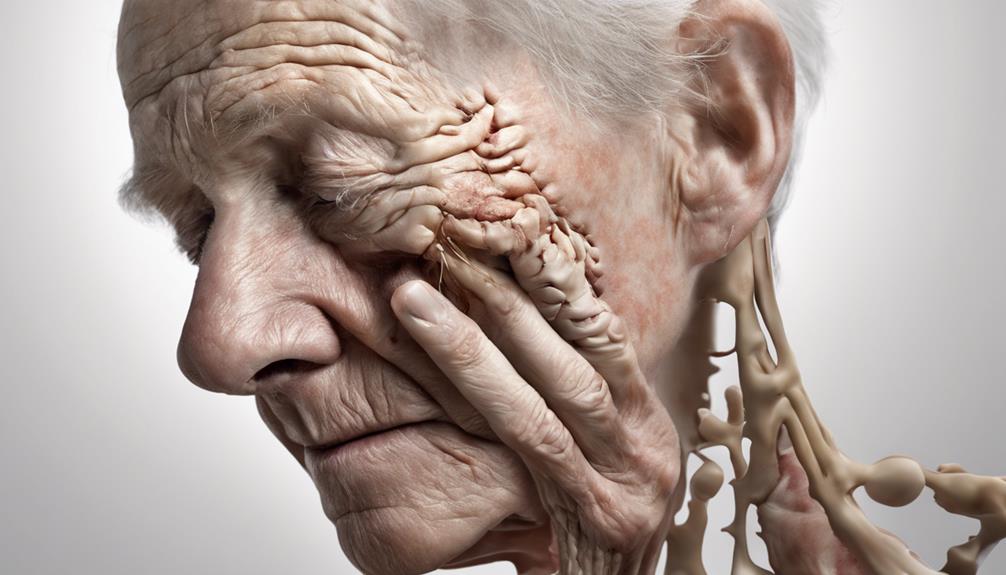Lewy Body Dementia can show as varying mental abilities, visual hallucinations, movements similar to Parkinson’s, difficulties with attention, memory issues, cognitive fluctuations, disruptions in sleep, delusions, and motor problems. These signs can affect daily activities and quality of life. Identifying these symptoms early is crucial for helping and caring for those with this condition. Recognizing these signs helps caregivers and healthcare providers offer the right support. Understanding these symptoms is key for navigating life with Lewy Body Dementia. Additional information on these symptoms is provided for a more in-depth comprehension.
Key Takeaways
- Fluctuating mental functioning and cognition.
- Parkinson's-like movements and motor symptoms.
- Visual hallucinations and delusions.
- Attention challenges and memory difficulties.
- Emotional fluctuations and cognitive changes.
Fluctuating Mental Functioning
In Lewy Body Dementia, fluctuating mental functioning manifests as unpredictable shifts in alertness and cognition throughout the day. This means that individuals with LBD may experience sudden changes in their ability to pay attention and stay focused.
Imagine trying to concentrate on a task, and then feeling confused or disoriented out of the blue. These fluctuations can make it tough for people with LBD to participate in daily activities consistently.
As caregivers, we often notice these unpredictable shifts in our loved one's cognitive abilities. Understanding and managing these changes in mental functioning is vital for providing the right care to those affected by LBD.
Visual Hallucinations

Experiencing visual hallucinations is a common and challenging aspect of living with Lewy Body Dementia, impacting a significant percentage of individuals affected by the condition. These hallucinations, involving seeing people, animals, or objects that aren't actually present, are distressing for both the individual and their caregivers. They're typically detailed, vivid, and may occur early in the disease process.
Visual hallucinations in LBD can be intermittent, fluctuating in intensity, making it difficult to differentiate between reality and illusions. Proper management and understanding of these hallucinations are essential for comprehensive care. It's crucial to create a supportive environment for individuals experiencing visual hallucinations, reassuring them and helping them navigate through these distressing episodes. Caregivers play a vital role in providing comfort and ensuring safety during these times.
Educating oneself about visual hallucinations in Lewy Body Dementia can lead to better care practices and improved quality of life for those affected by this challenging symptom.
Parkinsons-Like Movements
Visual hallucinations in Lewy Body Dementia can be distressing, and another challenging aspect of this condition is the presence of Parkinson's-like movements. These movement symptoms, reminiscent of Parkinson's disease, include tremors, muscle stiffness, and slow movements. They occur due to the degeneration of dopamine-producing neurons in the brain, leading to postural instability, gait problems, and difficulties with balance. These issues can greatly impact daily activities and quality of life for individuals with Lewy Body Dementia. Treatment for Parkinson's-like movements in LBD may involve physical therapy, medications, and lifestyle modifications to help manage these symptoms effectively.
| Symptoms of Parkinson's-like Movements: | |
|---|---|
| – Tremors | – Muscle stiffness |
| – Slow movements | – Postural instability |
| – Gait problems | – Balance issues |
Understanding these movement symptoms and their connection to dopamine-producing neuron degeneration is essential in providing care and support for individuals experiencing Lewy Body Dementia.
Attention Challenges

Attention challenges in Lewy Body Dementia can present as fluctuating alertness and difficulties in maintaining focus. These cognitive fluctuations can impact daily activities and decision-making. Here are three key points to help you understand attention challenges in Lewy Body Dementia:
- Fluctuating Alertness: Individuals with Lewy Body Dementia may experience times when they're more alert and other times when they seem confused or disoriented. These fluctuations in alertness can make it challenging to stay focused on tasks or conversations.
- Difficulty Maintaining Focus: Attention lapses are common in Lewy Body Dementia, leading to issues with concentration and memory. It may be hard for individuals with LBD to follow instructions, engage in activities, or even hold a conversation due to these focus difficulties.
- Impact on Daily Life: Attention challenges can have significant implications for daily living, including safety concerns. Caregivers play a vital role in monitoring individuals with LBD to safeguard their well-being and provide support in managing attention deficits.
Memory Difficulties
Memory difficulties in Lewy Body Dementia can cause forgetfulness in daily tasks, making it hard to recall recent events.
This can lead to confusion with time and difficulty remembering appointments or conversations.
Managing medications and following instructions may become challenging due to these memory impairments.
Forgetfulness in Daily Tasks
In daily life, individuals with Lewy Body Dementia commonly struggle with forgetfulness, impacting their ability to remember routine tasks like taking medication. This forgetfulness can cause frustration and confusion, making it challenging to maintain independence in daily activities.
Here are some ways forgetfulness in daily tasks can manifest in individuals with Lewy Body Dementia:
- Forgetting to take medications at the right time, leading to missed doses and potential health risks.
- Struggling to remember important appointments or scheduled activities, causing disruptions in daily routines.
- Difficulty recalling where items are placed or following step-by-step instructions, hindering completion of tasks efficiently.
Understanding these challenges can help caregivers provide better support and assistance to those with Lewy Body Dementia.
Difficulty Recalling Recent Events
Getting through daily tasks with Lewy Body Dementia can present challenges, such as struggling to remember recent events, which is a common early symptom of the condition. Memory difficulties may manifest as forgetting recent conversations, appointments, or tasks.
Individuals with Lewy Body Dementia might find it hard to recall where they placed everyday items or what they did just a short while ago. These memory issues can have a substantial impact on daily functioning and independence. As the disease progresses, memory challenges may worsen, leading to more severe cognitive impairment.
It's essential to provide support and understanding to individuals experiencing these memory difficulties to help them navigate daily life with Lewy Body Dementia.
Confusion With Time
Struggling to orient oneself in relation to time is a prominent challenge faced by individuals with Lewy Body Dementia, often leading to confusion and difficulty with planning daily activities. When experiencing memory difficulties related to time, individuals with LBD may find it challenging to remember important details like the day, date, or time.
This can result in disorientation and affect their ability to organize daily tasks effectively. As a consequence, they may become more dependent on others for assistance with routines and activities. This increased dependency can create frustration for both the individual with LBD and their caregivers.
Proper diagnosis and management of these memory difficulties are essential for improving the quality of life and providing the necessary support.
Personality Changes

Personality changes in Lewy Body Dementia can lead to shifts in behavior and fluctuations in emotions. These changes might manifest as increased irritability, apathy, or emotional outbursts.
It's important to recognize and address these shifts to provide appropriate care and support for individuals with LBD.
Behavioral Shifts
Behavioral shifts in individuals with Lewy Body Dementia often result in noticeable changes in their character and actions, such as increased aggression or apathy. Caregivers play an important role in recognizing and managing these behavioral symptoms. Here are some common manifestations of personality changes in individuals with Lewy Body Dementia:
- Paranoia: Individuals may exhibit heightened suspiciousness or irrational fears.
- Social Withdrawal: They might isolate themselves from social interactions or activities they once enjoyed.
- Emotional Outbursts: Sudden and intense displays of emotions, like anger or sadness, can occur unpredictably.
Caregivers need to provide support, understanding, and a safe environment for individuals experiencing these challenging behavioral shifts.
Emotional Fluctuations
How do emotional fluctuations impact individuals with Lewy Body Dementia?
Emotional fluctuations, including mood changes and personality changes, are common symptoms of Lewy Body Dementia. These fluctuations can cause rapid shifts in emotions, leading to irritability, anxiety, or sudden outbursts of anger.
Individuals may exhibit uncharacteristic behaviors such as increased impulsivity, apathy, or social withdrawal due to the impact of Lewy bodies on the brain. Caregivers often observe inconsistencies in emotional responses that differ from the person's usual behavior.
Understanding and managing these emotional fluctuations are essential for providing appropriate support and care for individuals with Lewy Body Dementia. By recognizing these changes and responding with empathy and patience, caregivers can help individuals navigate the challenges posed by these emotional symptoms.
Cognitive Fluctuations

Experiencing unpredictable changes in alertness, attention, and thinking abilities characterizes the cognitive fluctuations seen in Lewy Body Dementia. These fluctuations can vary throughout the day, with periods of clarity followed by confusion or disorientation. Patients may encounter rapid shifts in cognitive function, making it challenging to foresee their level of awareness or responsiveness.
Here are some key points about cognitive fluctuations in Lewy Body Dementia:
- Fluctuating Alertness: Individuals with Lewy Body Dementia may have moments of heightened alertness where they're very attentive, followed by sudden periods of drowsiness or reduced awareness.
- Attention Variability: Their ability to focus on tasks or conversations may fluctuate, leading to difficulties in maintaining consistent attention levels.
- Thinking Abilities Fluctuation: Cognitive processes such as memory, problem-solving, and decision-making can vary significantly, impacting the individual's ability to engage in daily activities effectively.
Understanding and recognizing these cognitive fluctuations is essential for caregivers and healthcare providers to offer appropriate support and care for those affected by Lewy Body Dementia.
Sleep Disturbances

Sleep disturbances commonly manifest in individuals with Lewy Body Dementia, encompassing issues such as insomnia, excessive daytime sleepiness, and restless legs syndrome. In this condition, REM sleep behavior disorder is prevalent, leading to physically acting out dreams during sleep, potentially causing injuries.
People with LBD may also experience vivid dreams and nightmares, further disrupting their sleep patterns. Restless legs syndrome can contribute to discomfort and movement during sleep, making it crucial to enhance the overall quality of life. These disturbances not only impact the quality of sleep but can also worsen cognitive symptoms, leading to increased confusion and disorientation during the day.
Managing these sleep issues is essential in improving the overall quality of life for individuals with Lewy Body Dementia. By addressing these concerns, healthcare providers and caregivers can help improve sleep patterns, reduce daytime sleepiness, and minimize the risk of injuries associated with REM sleep behavior disorder.
Delusions and Hallucinations

Delusions and hallucinations are common symptoms of Lewy body dementia that can greatly impact individuals and their caregivers.
Visual hallucinations involve seeing things that aren't there, like people or animals, while auditory hallucinations involve hearing sounds or voices that aren't real.
Managing these symptoms may require adjustments in medication and behavioral interventions to help alleviate distress and improve quality of life.
Types of Hallucinations
In Lewy Body Dementia, vivid visual hallucinations involving people, animals, or objects that aren't real are common. These hallucinations can be distressing for both the individual experiencing them and their caregivers.
Here are some types of hallucinations that individuals with Lewy Body Dementia may experience:
- Visual Hallucinations: Seeing things that aren't there, such as people, animals, or objects.
- Auditory Hallucinations: Hearing sounds, voices, or music that have no external source.
- Olfactory Hallucinations: Smelling odors that aren't present in the environment.
Understanding these different types of hallucinations can help caregivers provide better support and care for individuals with Lewy Body Dementia.
Impact on Caregivers
Handling the challenges of managing delusions and hallucinations in individuals with Lewy Body Dementia can greatly impact caregivers.
Delusions, which are false beliefs or suspicions, and visual hallucinations, where individuals see things that aren't there, can be distressing for both the person with LBD and their caregivers. Caregivers play an essential role in providing support, reassurance, and creating a safe environment when dealing with delusions and hallucinations.
It's crucial for caregivers to educate themselves and communicate with healthcare professionals to develop effective strategies for addressing these symptoms. By understanding how to handle delusions and hallucinations with compassion and patience, caregivers can help improve the quality of life for individuals with Lewy Body Dementia.
Treatment Options Available
When addressing delusions and hallucinations in individuals with Lewy Body Dementia, it's important to prioritize non-pharmacological approaches over antipsychotic medications.
Here are some effective strategies to help manage these symptoms:
- Behavioral Interventions: Engage in calming activities and redirect attention away from the hallucinations or delusions.
- Environmental Modifications: Create a soothing and familiar environment to reduce triggers for hallucinations and delusions.
- Caregiver Education: Learn about non-pharmacological approaches to effectively support and assist individuals experiencing hallucinations and delusions.
Motor Symptoms

Motor symptoms in Lewy Body Dementia encompass a range of movement challenges, including tremors, muscle stiffness, and slow movements resembling those seen in Parkinson's disease. These symptoms can make everyday tasks like walking, dressing, and handling objects more difficult.
In addition to tremors and muscle stiffness, individuals with LBD may also experience postural instability, leading to problems with balance and coordination. This can result in a shuffling gait and issues with maintaining an upright posture. Parkinsonian symptoms such as a stooped posture, decreased arm swing, and freezing episodes can manifest in those with Lewy Body Dementia.
The progression of motor symptoms in LBD varies from person to person, impacting each individual uniquely. It's important for caregivers and healthcare professionals to provide support and assistance in managing these motor challenges to help maintain the individual's quality of life.
Frequently Asked Questions
What Are the First Signs of Lewy Body Dementia?
We notice subtle changes in behavior like cognitive fluctuations, hallucinations, and movement issues. Early signs might involve memory problems, attention difficulties, and behavioral shifts. Sleep disturbances and sensory changes, such as smell alterations, can also indicate Lewy Body Dementia.
What Is Life Expectancy of Someone With Lewy Body Dementia?
We've found that the life expectancy of individuals with Lewy Body Dementia can range from 5 to 7 years post-diagnosis. Factors such as age, overall health, and symptom progression play crucial roles in influencing survival rates.
How Do They Test for Lewy Body Dementia?
We evaluate Lewy Body Dementia through medical history, physical exams, brain imaging, blood tests, and neuropsychological assessments. These evaluations help identify symptoms and rule out other conditions. It's a thorough approach to diagnosing LBD.
What Are the Three Core Features of Lewy Body Dementia?
We'll cover the three core features of Lewy Body Dementia. They include cognitive fluctuations, visual hallucinations, and parkinsonism. These aspects are vital in distinguishing LBD from other forms of dementia and play a key role in diagnosis and management.
Conclusion
To sum up, comprehending the symptoms of Lewy body dementia is essential for early detection and proper management. To sum up, comprehending the symptoms of Lewy body dementia is essential for early detection and proper management. Recognizing overlapping symptoms, such as memory loss and cognitive decline, can help distinguish it from other neurodegenerative disorders. Additionally, being aware of early signs of Alzheimer’s to know can further assist in identifying specific characteristics that set these conditions apart, enabling more effective treatment strategies.
By identifying the signs such as fluctuating mental functioning, visual hallucinations, and Parkinson's-like movements, individuals can seek appropriate medical help and support.
It's vital to remember that each person may experience symptoms differently, but being aware of these common indicators can lead to a better quality of life for those affected by this condition.









